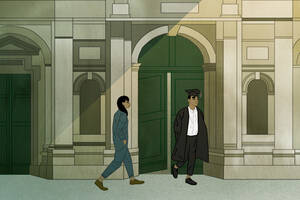
Lisa Röper
When Baby Boomers began to enter the job market in the 1960s, they found themselves in a tough spot. The huge supply of young workers outweighed demand for entry-level positions, leading to a slowdown in the growth of younger workers’ wages.
Luckily for them, the market dynamics would soon flip in their favor.
Today, Baby Boomers earn much more than their younger colleagues—which you might expect, since older workers generally earn more on average.
What’s surprising, though, is that the wage gap between older and younger workers is greater than when Boomers entered the job market. In fact, the gap between workers over 55 and those under 35 increased by 61 percent in the United States between 1979 and 2018.
So why didn’t Baby Boomers see their wages stay low throughout their careers? That is, with Boomers being such a large cohort, why did they not experience the same oversupply (and downward pressure on wages) as they moved into mid- and senior-level positions?
A new study by Kellogg assistant professor of strategy Nicola Bianchi and Matteo Paradisi of the Einaudi Institute for Economics and Finance shows why.
In short, the Boomers benefited from a variety of structural changes to the labor market. These shifts—like delayed retirement, the high cost of moving jobs, and stagnant firm growth—have been a boon to older workers, keeping them in higher-paying positions for longer.
This comes at the expense of younger workers, who cannot reach the ranks held by older workers. Instead, they face lower wages, slow career growth, and more frequent job changes.
“We know that worker demographics have changed—the workforce has become older—but the usual supply and demand dynamics have not applied,” Bianchi says. “In fact, the opposite is true. And it’s due to macroeconomic shifts, not necessarily from demographic shifts.”
Those shifts could mean trouble for firms who are looking to recruit and retain young workers, since firms often cannot offer high wages and the potential to rise in the ranks. “It’s going to be one of the biggest issues firms face in the coming years,” Bianchi says.
An aging workforce, earning more
Bianchi, a labor economist, became interested in studying the issue of changing workforce demographics after Italy raised its retirement age to 67 in 2011. The move, intended to shore up the country’s pension system, reflected the aging workforce around the world.
In Italy, the mean worker age increased by 19 percent from 1985 to 2019. And, as in America, as the average age of the workforce increased, so did the wages of older workers.
During that same period, those over 55 in Italy experienced huge average wage increases—33 percent for 56-year-olds and 53 percent for 65-year-olds. Those under 35, however, saw a mere 14 percent growth in wages. The difference in mean weekly wages between workers over 55 and those under 35 increased by a staggering 96 percent.
In fact, the trend—older workers seeing a disproportionate increase in wages—was found in high-income countries around the world. “We knew something new must be happening in the labor markets to explain this,” Bianchi says.
“Older workers have accrued more promotions and have been occupying those slots for longer, which means younger workers cannot reach those levels anymore.”
—
Nicola Bianchi
A simple explanation might be increasing wage inequality—the uneven distribution of wages among groups of people, which has been a documented phenomenon in high-income countries. After all, with older workers more likely to be in well-paid jobs, they would be the natural beneficiaries of the wealthy becoming wealthier. But Bianchi hypothesized that this new phenomenon could alternatively be explained by what he calls “negative career spillovers,” where an increasing number of older workers with longer careers reduce access to higher-paying positions for younger workers.
To study the issue, Bianchi analyzed three data sets: 35 years of confidential administrative data provided by the Italian Social Security Institute; employer-employee Social Security data provided by the German government; and information on 14 high-income economies, including the United States, from the Luxembourg Income Survey database. Together, these sources include information on more than 44 million workers.
The wage gap is due to rank gap, not inequality
Bianchi’s analysis painted an increasingly poor career picture for young workers.
In Italy, for example, the likelihood of workers under 35 earning weekly wages in the top quartile declined by 34 percent from 1985 to 2019. In the same period, the probability of those over 55 earning top-quartile wages increased by 32 percent.
To find out why younger workers were doing so poorly, Bianchi decided to mathematically quantify the impact of various potential explanations for the age wage gap. He measured changes in the distributional gap (how wages were distributed across all workers, independent of the movement of younger and older workers along the distribution of wages), as well as changes in the rank gap (how many older vs. younger workers were positioned across various parts of the wage distribution, independent of the shape of that wage distribution). If the distributional gap accounted for most of the age wage gap, this would be consistent with an income inequality explanation. If, on the other hand, the rank gap was the bigger contributor, this would be consistent with a negative career spillover explanation.
From this test, he was able to rule out income inequality as the major culprit.
Instead, the researchers’ analysis revealed, the rank gap was the primary factor of the increase in the wage gap between older and younger workers. That is, the wage gap can be traced back to the increased propensity for older workers to occupy jobs at the upper tail of the wage distribution, and vice versa for younger workers—a finding consistent with negative career spillovers, where older workers crowd out younger ones for the best paid jobs.
“Older workers have accrued more promotions and have been occupying those slots for longer, which means younger workers cannot reach those levels anymore, because there are no more available spots,” Bianchi says.
But why can’t firms just create more high-level positions to accommodate younger workers on the rise? The researchers believe that prior to the 1970s, when Boomers entered the job market, firms experienced higher growth than today, leading to more open positions at the top. Boomers eventually ascended into those positions.
While high-growth startups often make the news, the reality is that today most firms are mature and expanding slowly if at all, leading to an inability to create more higher-ranked positions. That means Boomers have been staying in senior positions since this stagnation began, which Bianchi believes was underway by the late 1970s.
Younger workers lose throughout most of their career
The analysis also found that over time, workers under 35 have become more likely to enter the job market with progressively lower wages, and then see slow wage growth throughout much of their careers.
This suggests that their plight isn’t simply the result of experience suddenly becoming more valued in the labor force, the researchers argue. If younger workers were being disproportionately penalized for inexperience (compared to their older colleagues, who entered the workforce when experience mattered less), you’d expect to see them earn low wages for a while, “but at some point, they should gain more because they are getting more experienced,” Bianchi says. “But we don’t see that. For the first 18 years of their careers, they keep losing. Their wage growth over time is worse than what it used to be.”
The problem for younger workers is exacerbated by the fact that the concentration of older workers increased even more among the highest-paying firms.
“Older workers tend to stay attached to a job longer if it is paying more, which gives them a huge advantage,” Bianchi says. Locked out of high-paying firms, younger workers are relegated to lower-paying firms and must rely on job-hopping to advance their careers. In Italy, the share of under-35 workers who left or lost a job increased from 27 percent in 1985 to 44 percent in 2019.
But job-hopping has proven to be an increasingly ineffective career strategy for young workers. The data show that younger Italian workers’ financial gains by moving from firm to firm have also declined by 34 percent over time.
“Over time, their moves from firm to firm result in lower monetary gains,” Bianchi says. “They become more likely to move and more willing to move for less.”
Problem will persist after Baby Boomers retire
But aren’t we in the midst of the great Baby Boomer retirement? Will these issues solve themselves once this huge cohort of older workers eventually does retire?
“Tough to say,” Bianchi says. “It’s complicated.” First, with lifespans increasing, it’s natural for older workers to stay in their positions for longer, whether they want to or need to. And in most high-income economies, public retirement funds aren’t sustainable unless workers stay on the job longer.
But even if we do see a big retirement wave, Bianchi thinks this congestion may persist.
That’s because the issues lie not only with demographics but also with macroeconomic trends, like the prevalence of mature companies with little room to add more senior positions.
That means fewer highly ranked spots for the foreseeable future. And while having older workers is good for many firms—they offer a wealth of experience and are valuable members of the company—it can lead to cultures and processes that alienate younger workers.
And, in the long run, a failure to attract (and develop) younger workers is also bad for employers, Bianchi believes. After all, firms can benefit from younger workers’ fresh perspectives and willingness to learn new skills. One potential solution is giving firms subsidies to hire younger workers—an issue that Bianchi is studying now—but, he says, “there is no easy solution to this problem.”
Emily Ayshford is a freelance writer in Chicago.
Nicola Bianchi and Paradisi, Matteo. 2022. “Countries for Old Men: An Analysis of the Age Wage Gap.” Working paper.



